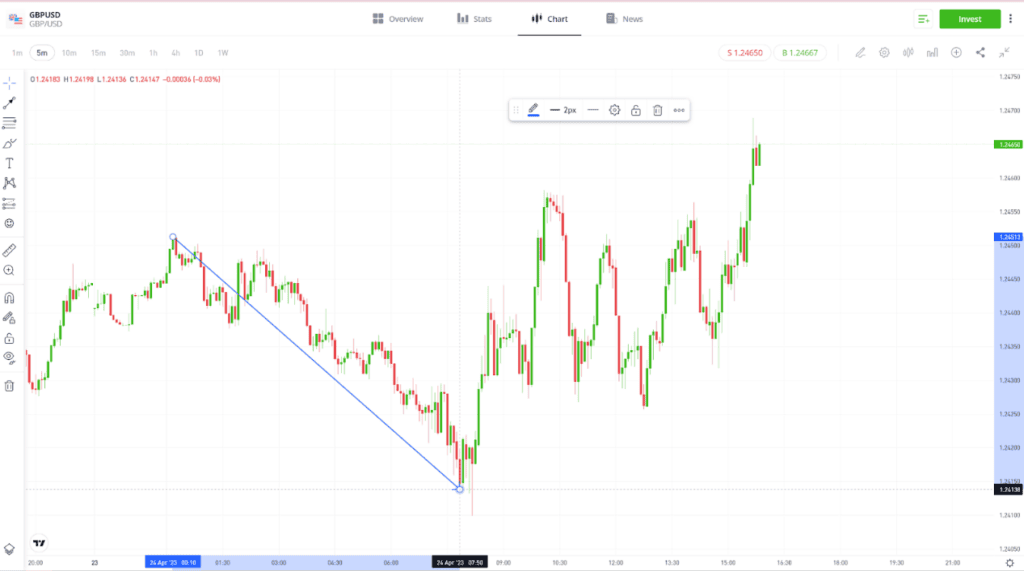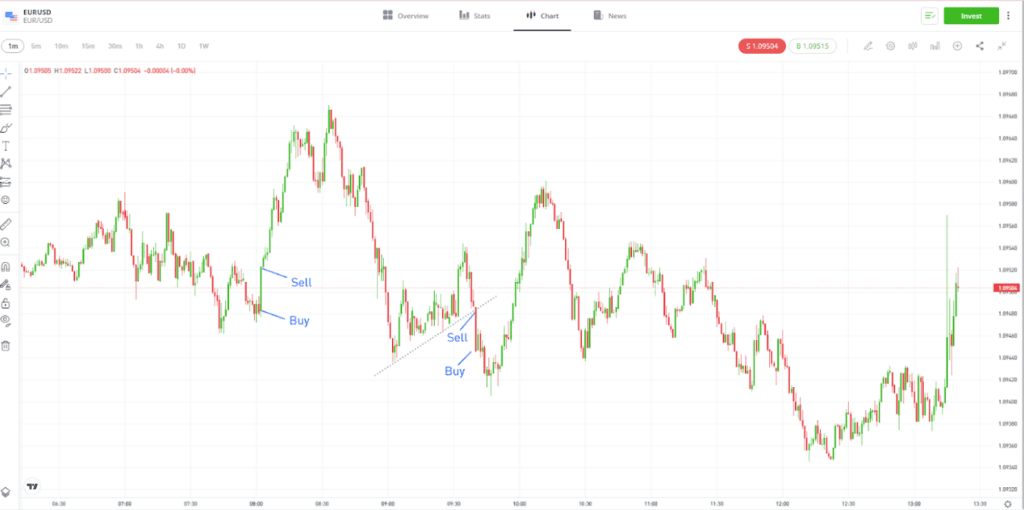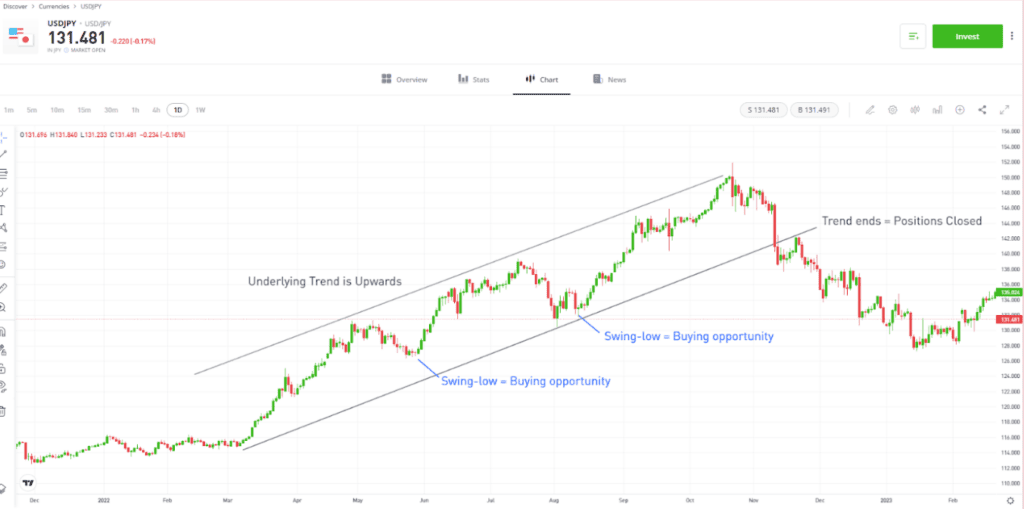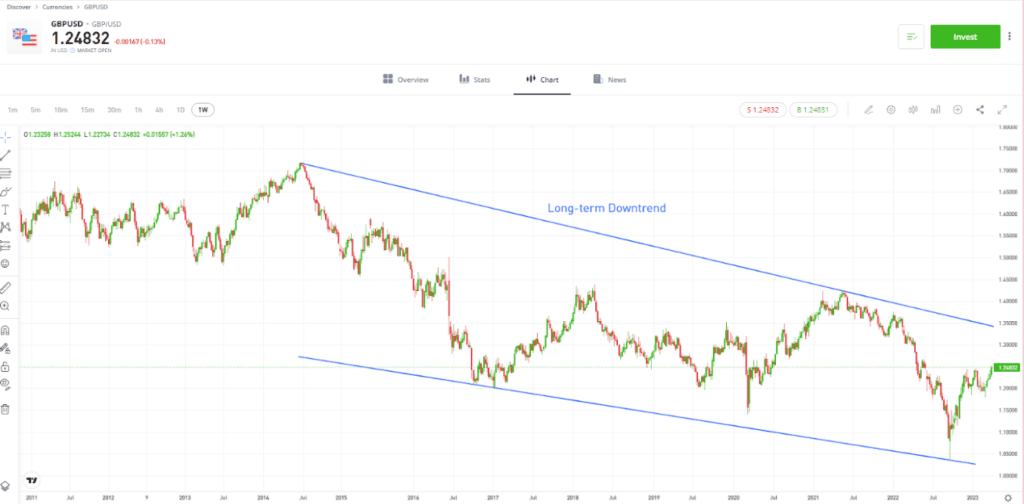Odată ce ai înțeles bine mișcările de preț de pe piața valutară, este esențial să dezvolți o strategie de tranzacționare bine definită. În acest ghid, vom explora conceptul de strategie de tranzacționare Forex, vom examina diverse exemple de strategii și vom discuta despre modul în care îți poți dezvolta propria abordare personalizată.
O strategie de tranzacționare Forex servește ca o foaie de parcurs, oferind orientări pentru punctele de intrare și ieșire, gestionarea ordinelor stop-loss, implementarea tehnicilor de gestionare a portofoliului și menținerea disciplinei pe parcursul călătoriei de tranzacționare.
Ce este o strategie de tranzacționare Forex?

O strategie de tranzacționare Forex este un plan sistematic și structurat care descrie abordarea în tranzacționarea valutelor. Aceasta cuprinde un set de reguli și principii care ghidează procesul de luare a deciziilor pe piața Forex.
O strategie bine concepută ține cont de toleranța ta la risc, de stilul de tranzacționare și de obiectivele financiare. De asemenea, încorporează tehnici de analiză și indicatori pentru a identifica potențialele oportunități de tranzacționare și pentru a gestiona eficient riscurile.
Crearea unei strategii de tranzacționare de succes implică un proces de perfecționare continuă. Aceasta necesită testarea retroactivă a datelor istorice, analizarea diferitelor scenarii de piață și adaptarea la condițiile schimbătoare ale pieței.
Sfat: Urmând o strategie, poți elimina deciziile impulsive de tranzacționare, crescând astfel șansele de a obține profituri consistente.
Exemple de strategii de tranzacționare Forex

Piața valutară oferă o gamă largă de strategii de tranzacționare care se potrivesc diferitelor stiluri și preferințe de tranzacționare. Iată câteva exemple de strategii populare de tranzacționare Forex:
Tranzacționare Forex de zi
Tranzacționarea pe timp de zi pe piața Forex presupune deschiderea și închiderea tranzacțiilor în aceeași zi de tranzacționare. Traderii de zi urmăresc să profite de pe urma fluctuațiilor de preț pe termen scurt și, de obicei, nu păstrează poziții peste noapte.
Sfat: Această strategie minimizează expunerea la riscurile pieței și se concentrează pe indicatori de analiză tehnică, cum ar fi mediile mobile, liniile de tendință și modelele grafice.
Traderii de zi execută adesea mai multe tranzacții pe parcursul zilei, urmărind să obțină câștiguri mici, dar frecvente. În graficul GBPUSD de mai jos, poți vedea tendința de scădere între orele 00:00 AM și 07:50 AM. Este posibil ca traderii Forex să nu monitorizeze aceste mișcări de preț în mod activ în timpul nopții.
| GBPUSD – graficul de preț – 5 minute – Strategia Day Trading |

Performanțele anterioare nu reprezintă o indicație a rezultatelor viitoare
Sursă: eToro
Forex scalping
Tranzacționare Forex scalping
Forex scalping este o strategie de tranzacționare de mare viteză care implică deschiderea și închiderea pozițiilor într-o succesiune rapidă, adesea în câteva secunde sau minute. Scalperii urmăresc să profite de mișcările mici ale prețurilor și să acumuleze profituri dintr-un număr mare de tranzacții.
Această strategie necesită o concentrare intensă, disciplină și capacitatea de a reacționa rapid la schimbările de piață. Scalperii se bazează pe indicatori de analiză tehnică pe termen scurt și pe o gestionare riguroasă a riscurilor pentru a-și atinge obiectivele de tranzacționare.
Conform Termenilor și Condițiilor eToro, scalping-ul nu este permis. Pentru a afla mai multe despre regulament, consultă Termenii și Condițiile la acest link: https://www.etoro.com/ro/customer-service/terms-conditions/

Performanțele anterioare nu reprezintă o indicație a rezultatelor viitoare
Sursă: eToro
Tranzacționare Forex swing
Tranzacționarea Forex swing se concentrează pe captarea mișcărilor mari de preț pe o perioadă de câteva zile sau săptămâni. Traderii de tip swing pot intra în tranzacții pe baza retragerilor în tendință, urmărind să cumpere la nivelurile de suport și să vândă la nivelurile de rezistență.
Această strategie combină analiza tehnică cu analiza fundamentală, deoarece traderii swing iau în considerare atât modelele de preț, cât și factorii macroeconomici care pot influența mișcările valutare.
Sfat: Swing trading implică puține tranzacții și menținerea pozițiilor pentru mai mult timp. Această strategie este uneori preferată de traderii care petrec mai puțin timp monitorizând piețele.

Performanțele anterioare nu reprezintă o indicație a rezultatelor viitoare
Sursă: eToro
Strategia de tranzacționare a poziției
Tranzacționarea pe poziții se aseamănă cu investițiile pe piața valutară, cu tranzacții pe termen mediu și lung. Traderii de poziții se bazează pe analiza fundamentală, monitorizând îndeaproape indicatorii economici, politicile băncilor centrale, evenimentele geopolitice și tendințele pe termen lung.
Aceștia urmăresc să capteze mișcările semnificative ale pieței și sunt dispuși să suporte fluctuațiile temporare ale prețurilor. Tranzacționarea pe poziții necesită răbdare, o înțelegere profundă a tendințelor economice globale și o perspectivă pe termen lung.

Performanțele anterioare nu reprezintă o indicație a rezultatelor viitoare
Sursă: eToro
Efectuează cercetări amănunțite, fii la curent cu știrile și evoluțiile pieței și îmbunătățește-ți continuu strategiile pentru a-ți spori șansele de succes.
Cum să îți dezvolți propria strategie de tranzacționare Forex
Pentru a-ți dezvolta propria strategie de tranzacționare Forex, poți lua în considerare următorii factori:
- Concordanța cu piața: Unele strategii funcționează mai bine în anumite condiții de piață. Evaluează caracteristicile pieței în care dorești să tranzacționezi și selectează o strategie care se aliniază cu aceste condiții.
- Flexibilitate: Strategia ta de tranzacționare ar trebui să permită adaptabilitatea la dinamica schimbătoare a pieței. Piețele evoluează în mod constant, iar capacitatea de a-ți ajusta abordarea atunci când este necesar, este crucială.
- Schimbarea paradigmei: Rămâi deschis la adoptarea de noi strategii sau la modificarea celor existente pe baza unor informații noi sau a unor schimbări de piață. Rămâi informat cu privire la tendințele emergente și la tehnicile de tranzacționare inovatoare.
- Gestionarea riscurilor: Încorporează principiile de gestionare a riscurilor în strategia ta. Determină dimensiunea adecvată a poziției, stabilește ordinele de stop-loss și ratele de risc-recompensă pentru a-ți proteja capitalul.
- Gestionarea timpului: Definește-ți rutina de tranzacționare și acordă timp pentru analiză, executarea tranzacțiilor și revizuire. Consecvența și disciplina în aderarea la planul de tranzacționare sunt esențiale.
Concluzie

O strategie de tranzacționare Forex bine definită este vitală pentru succesul pe piețele valutare. Efectuează cercetări amănunțite, fii la curent cu știrile și evoluțiile pieței și perfecționează continuu strategiile pentru a-ți spori șansele de succes.
Nu uita că poți avea mai multe strategii care funcționează simultan, fiecare dintre ele vizând condiții de piață sau intervale de timp diferite. Deși este posibil să preferi anumite strategii, este esențial să rămâi deschis și flexibil, adaptându-te la condițiile de piață în schimbare.
Vizitează Academia eToro pentru a afla mai multe despre tranzacționarea Forex și perechile valutare.
Quiz
Întrebări frecvente
- Când sunt volumele tranzacțiilor Forex cele mai mari?
-
Volumele tranzacțiilor Forex sunt, de obicei, cele mai mari în timpul sesiunilor de tranzacționare care se suprapun în centrele financiare majore. Aceste sesiuni includ sesiunea de la New York (de la 8:00 AM la 5:00 PM EST) și sesiunea de la Londra (de la 3:00 AM la 12:00 PM EST). În aceste perioade, există o activitate și o lichiditate sporită a pieței.
- Câte tranzacții înregistrează traderii de zi în fiecare zi?
-
Numărul de tranzacții efectuate de traderii de zi poate varia semnificativ în funcție de stilul lor de tranzacționare, de condițiile de piață și de preferințele personale. Unii traderi de zi pot executa câteva tranzacții cu probabilitate ridicată în fiecare zi, în timp ce alții se pot angaja într-un număr mai mare de tranzacții de durată mai scurtă.
- Ce determină modificarea cursurilor valutare?
-
Cursurile de schimb valutar sunt influențate de diverși factori, inclusiv de indicatori macroeconomici (cum ar fi ratele dobânzilor, inflația și creșterea PIB-ului), de evenimente geopolitice, de politicile băncilor centrale și de sentimentul pieței. Dinamica cererii și a ofertei pe piața valutară determină mișcările prețurilor valutare, ceea ce duce la fluctuații ale cursurilor de schimb.
Informațiile din acest ghid au exclusiv scop educativ și nu ar trebui considerate drept sfaturi pentru investiții sau recomandări personale, nici oferte sau solicitări de cumpărare sau vânzare a oricăror instrumente financiare.
Acest material a fost pregătit fără a lua în considerare orice fel de obiective particulare de investiții sau situații financiare și nu a fost creat în conformitate cu cerințele legale și de reglementare a promovării cercetării independente. Nu toate instrumentele și serviciile financiare menționate sunt oferite de eToro și orice referiri la performanța anterioară a unui instrument financiar, index sau pachet de investiții, nu sunt și nu ar trebui considerare un indicator fiabil al rezultatelor viitoare.
eToro nu face nicio declarație și nu își asumă nicio responsabilitate cu privire la acuratețea sau caracterul complet al conținutului acestui ghid. Asigură-te că înțelegi riscurile implicate în tranzacționare înainte de a implica capital. Nu risca niciodată mai mult decât ești pregătit să pierzi.


